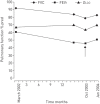Management of sarcoidosis in clinical practice
- PMID: 27246591
- PMCID: PMC9487239
- DOI: 10.1183/16000617.0013-2016
Management of sarcoidosis in clinical practice
Abstract
Sarcoidosis is a systemic disease of unknown cause with very diverse presentation, outcome, severity and need for treatments. While some presentations may be very typical, for many patients, the presentation is nonspecific, with shared associations with other diseases at times being by far more frequent or misleading, which can be a cause of significant delay and often several consultations before a diagnosis of sarcoidosis can be confirmed. This is particularly the case when pulmonary manifestations are in the forefront. The diagnosis relies on three well-known criteria. In clinical practice, these criteria are not easily implemented, particularly by physicians without expertise in sarcoidosis, which can lead to a risk of either under- or over-diagnosis. Qualifying the presentation according to sarcoidosis diagnosis is essential. However, it is often not easy to classify the presentation as typical versus compatible or compatible versus inconsistent. Further investigations are needed before any other hypothesis is to be considered. It is important to detect events and to determine whether or not they are indicative of a flare of sarcoidosis. Eventually, treatment needs to be related to the correct indications. The evaluation of the efficacy and safety of treatments is crucial. To address such issues, we present five emblematic cases that illustrate this.
Copyright ©ERS 2016.
Conflict of interest statement
Conflict of interest: Disclosures can be found alongside the online version of this article at
Figures






References
-
- Statement on sarcoidosis. Am J Respir Crit Care Med 1999; 160: 736–755. - PubMed
-
- Valeyre D, Prasse A, Nunes H, et al. . Sarcoidosis. Lancet 2014; 383: 1155–1167. - PubMed
-
- Baughman RP, Nagai S, Balter M, et al. . Defining the clinical outcome status (COS) in sarcoidosis: results of WASOG Task Force. Sarcoidosis Vasc Diffuse Lung Dis 2011; 28: 56–64. - PubMed
Publication types
MeSH terms
LinkOut - more resources
Full Text Sources
Other Literature Sources
Medical
